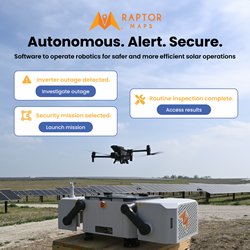University-Affiliated Business Applies for Patent for Solar-Cell Efficiency Technology
Silicon Solar Solutions receives $150,000 grant for invention
Monday, February 18, 2013
Douglas Hutchings (left), chief executive officer of Silicon Solar Solutions Inc., and Matthew Young, a member of Picasolar, a graduate business plan competition team at the University of Arkansas, pose in a lab at the Arkansas Research and Technology Park. Photo by Russell Cothren, University of Arkansas
FAYETTEVILLE, Ark. – Silicon Solar Solutions Inc., a Genesis Technology Incubator client at the University of Arkansas, has developed a new technology that could improve the efficiency of solar cells by 15 percent, thereby potentially saving manufacturers millions of dollars in production costs.
The start-up company at the Arkansas Research and Technology Park has submitted an application for a full patent on a self-aligned hydrogenated selective emitter for N-type solar cells, moving the patent from "provisional" to "pending," said Douglas Hutchings, chief executive officer of Silicon Solar Solutions.
"If successful, this approach represents the single largest technology leap in solar since 1974," Hutchings said. "We have demonstrated it on lab-scale cells already. We're all excited."
Seth Shumate, a graduate student at the U of A and senior scientist at Silicon Solar Solutions, invented the emitter. In December, the National Science Foundation awarded the company a $150,000 small-business grant to continue its development.
The technology is at the heart of a joint venture being developed by Silicon Solar Solutions and Picasolar, a graduate business competition team at the university that includes Shumate as a member. On Jan. 26, Picasolar took first place at the 2013 IBK Capital-Ivey Business Plan Competition and took home a cash award of $20,000.
Shumate, a doctoral student in the microelectronics-photonics program at the university, uses a vacuum chamber in a laboratory at the Arkansas Research and Technology Park to conduct his experiments. The chamber has a tungsten filament, similar to a light bulb, which heats to 3,452 degrees Fahrenheit. When hydrogen is introduced to the chamber it hits the surface of a tungsten filament, separating the hydrogen atoms.
"Those atoms then go into the solar cell and do their magic," Shumate said.
Selective emitter technology for solar cells has so far involved complex processes with at least two or more steps. The technology innovation put forward by Silicon Solar Solutions is a single-step method for creating a selective emitter by using atomic hydrogen to deactivate impurities in the emitter. It increases solar power conversion efficiency and reduces the amount of silver needed to produce high-efficiency solar cells, thereby lowering material costs.
The National Science Foundation Phase I grant came through the Small Business Innovation Research Program, which allows federal agencies to stimulate technological innovation in the private sector by strengthening small businesses that meet federal research and development needs. The program also is intended to increase the commercial application of federally supported research results.
Silicon Solar Solutions will raise $60,000 of outside investment for the emitter to secure an additional $30,000 from the National Science Foundation. Hutchings said it hopes to receive a $750,000 Phase II grant in January 2014 to demonstrate the lab results on industrial-quality cells and start implementing the technology in existing solar-cell manufacturing lines.
Featured Product

Raptor Maps - The integrated operating system for end-to-end solar management
Operate autonomous drones and other robotics technology on your solar farms with Raptor Maps' robotics operations platform. Our end-to-end solution allows you to build and schedule data collection missions, to analyze collected data through our analytics engine, and to address identified issues through our remediation intelligence suite. From construction monitoring to substation inspections to SCADA-alert generation missions, Raptor Robotics gives your team unparalleled insights into the health and status of your project. Improve the safety, efficiency, and scale of your operations with Raptor Robotics.
